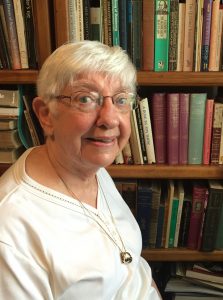I am 90 years old and continue to be an ardent believer in Edward De Vere as the real Shakespeare.

I was a business major at the University of North Carolina-Greensboro and have a background of work in a university school of business administration. I have been a long-time reader of literature in economics, the classics, and more. My life was spent in college and university communities for more than 50 years, so there was always intellectual stimulation and opportunity to see dramatic and musical programming.
My husband was on many publishers’ mailing lists, and in the mid-1970s he received notice of the publication of a four-volume set by the Kennikat Press, put together by Ruth Loyd Miller, a Louisiana attorney. It included “Shakespeare” Identified by J. Thomas Looney, Hidden Allusions in Shakespeare’s Plays, by Eva Turner Clark, and A Hundreth Sundrie Flowers. I ordered immediately, for a total of $72.50. It took a while to absorb these volumes, but I became convinced that Edward De Vere, the Seventeenth Earl of Oxford, was the real Shakespeare.
My husband, Leland R. Cooper, was encouraging in my quest to discover the real author of the Shakespeare canon. Soon we became telephone and postal friends with Mrs. Ruth Loyd Miller and her husband, Judge Minos D. Miller, Jr. They suggested that I become a member of the Shakespeare Oxford Society, where I was inspired by many of the early members of the SOS. From that beginning, I remained a member and did attend one meeting of the Society in the 1970s.
In 1981 we planned a trip to England and got good advice from the Millers about how to identify people and places in East Anglia related to De Vere. We visited his birthplace at Castle Hedingham and several churches which he had sponsored and which were identified by his five-pointed star. One church, St. Stephen’s Chapel at Bures, contained several effigies of the De Vere family. Those with legs crossed identified those who had gone on a Crusade. We visited with Colonel and Mrs. Probert who had helped restore this old church.
Over the years, I continued to be amazed by the writing and research being done on the subject of the Shakespeare Authorship Question. My first real attention to the problem was enhanced in a Shakespeare class I attended at Appalachian State University in Boone, North Carolina. It was taught by Dr. Hans Heymann, a native of Germany who had come to this country after being brought here as a prisoner of war in World War II. He spent the major part of his career at two North Carolina colleges after finding a welcome in this country. Unlike some of his colleagues, he was open to the possibility of there being an alternative to the man from Stratford. Calvin Hoffman’s book, The Murder of the Man Who Was Shakespeare, was among the first being considered at that time. I reported on that book to the class at the professor’s request. Dr. Heymann once remarked that the Germans had done more research on Shakespeare than the English.
When Charles Beauclerk (Burford), a co-lineal descendant of Edward de Vere, lectured in this country, I sponsored his visit to Appalachian State University through a Greensboro, N.C. group of Oxfordians. He spoke to a general faculty audience and to a group of high school students. The students were well prepared by their English instructor and responded to the lecture with thoughtful questions and lively participation.
I taped William Buckley’s interview with Charlton Ogburn, Jr., and a Stratford believer. There was no doubt that Ogburn won that one. I gave the tape to a Tennessee high school teacher for use in her classes. She shook up the establishment there.
Over the years, I continued to collect and read books on the subject, including authors: John H. Stotsenburg, Gertrude C. Ford, Dorothy and Charlton Ogburn, Charlton Ogburn, Jr., Craig Huston, Peter Sammartino, Joseph Sobran, Verily Anderson, Rhoda Henry Messner, Mark Anderson, Warren Hope and Kim Holston, Hank Whittemore, William Farina, Richard Malim, Roger A. Stritmatter, and Lynne Kositsky. Incidentally, these last four were published by McFarland & Company, Inc., Publishers, of Jefferson, NC, which happens to be our publisher of oral histories (The Pond Mountain Chronicle and The People of the New River).
— Mary Lee Cooper
“How I Became an Oxfordian” is edited by Bob Meyers. You may submit your essay on this topic (500 words or less in an editable format such as MS Word), along with a digital photo of yourself, to: communications@shakespeareoxfordfellowship.org. Also include a sentence about yourself (e.g., “John J. Smith is a businessman in San Francisco.”).
You may join the SOF or renew your membership at our membership page.


